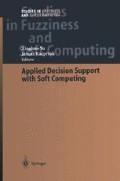Abstract
This chapter reports a real application of fuzzy decision tree to a reservoir recognition in the logging area for oilfield exploration. Reservoir fluid recognition is an important but difficult task in providing a comprehensive explanation for logging. A good recognition method can provide reliable evidence for building a standard of explanation in a region. Since there is much vagueness in the reservoir fluid recognition and there are considerable differences of geological structure in different regions, it is very difficult to establish a uniform mathematical model to recognize the reservoir. The commonly used methods for reservoir recognition include empirical formula, synthetic evaluation, fuzzy clustering, etc. Unfortunately, these methods fail to meet many applications’ requirements. For example, the empirical formula and synthetic evaluation methods could not handle fuzzy or vague data while the fuzzy clustering could not give a good recognition of oil-water layer. By applying the fuzzy decision tree induction method to the problem of reservoir recognition in an oilfield of northern China, we find the recognition results encouraging.
Access this chapter
Tax calculation will be finalised at checkout
Purchases are for personal use only
Preview
Unable to display preview. Download preview PDF.
References
S. M. Chen, “A weighted fuzzy reasoning algorithm for medical diagnosis,” Support Systems, vol. 11, pp. 37–43, 1994
H. C. Tseng and D. W. Teo, “Medical expert system with elastic fuzzy logic, ” 3rd IEEE International Conference on Fuzzy Systems, vol. 3, pp. 2067–2071, 1994
D. S. Yeung and E. C. C. Tsang, “A comparative study on similarity-based fuzzy reasoning methods,” IEEE Trans. System, Man, Cybernetics, vol. 27, no. 2, pp. 216–226, 1997
D. S. Yeung and E. C. C. Tsang, “Weighted fuzzy production rules,” Fuzzy Sets and Systems, vol. 88, pp. 299–313, 1997
D. S. Yeung and E. C. C. Tsang, “A Multilevel weighted fuzzy reasoning algorithm for expert systems”, IEEE Transactions on System, Man and Cybernetics, vol. 28, no. 2, pp. 149–158, 1998
N. K. Kasabov, “Learning fuzzy rules and approximate reasoning in fuzzy networks and hybrid systems,” Fuzzy Sets and Systems, vol. 82, pp. 135–149, 1996
J. R. Quinlan, “Induction of decision trees,” Machine Learning, vol. 1, pp. 81–106, 1986
Y. Yuan and M. J. Shaw, “Induction of fuzzy decision trees,” Fuzzy Sets and Systems vol. 69, pp. 125–139, 1995
T. Kohonen, “Self-Oganization and Associate Memory,” Springer, Berlin, 1988
S. Mitra and S. K. Pal, “Self-organizing neural networks as a fuzzy classifier,” IEEE Trans. on System, Man and Cybernetics, vol. 24, no. 3, pp. 385–399, 194
K. J. Cios and L. M. Sztandera, “Continuous ID3 algorithm with fuzzy entropy measures,” Proc. IEEE Internat. Conf. On Fuzzy Systems (San Diego, CA, 8–12, Match 1992 ) pp. 469–476
D. S. Yeung, X. Z. Wang, E. C. C. Tsang, Learning Weighted Fuzzy Rules from Example with Mixed Attributes by Fuzzy Decision Trees, in Proceedings of IEEE International Conference on System, Man, and Cybernetics (October 12–15, 1999, Tokyo, Japan ) pp. 349–354
X.Z. Wang, E.C.C. Tsang, D.S. Yeung, A Comparative Study on Heuristic Algorithms for Generating Fuzzy Decision Trees, IEEE Transactions on Systems, Man, and Cybernetics, Part B, vol. 31 (Issue.2), April 2001, pp. 215–226
Author information
Authors and Affiliations
Editor information
Editors and Affiliations
Rights and permissions
Copyright information
© 2003 Springer-Verlag Berlin Heidelberg
About this chapter
Cite this chapter
Wang, X.Z., Yeung, D.S., Tsang, E.C.C., Lee, J.W.T. (2003). Application of Fuzzy Decision Trees to Reservoir Recognition. In: Yu, X., Kacprzyk, J. (eds) Applied Decision Support with Soft Computing. Studies in Fuzziness and Soft Computing, vol 124. Springer, Berlin, Heidelberg. https://doi.org/10.1007/978-3-540-37008-6_16
Download citation
DOI: https://doi.org/10.1007/978-3-540-37008-6_16
Publisher Name: Springer, Berlin, Heidelberg
Print ISBN: 978-3-642-53534-5
Online ISBN: 978-3-540-37008-6
eBook Packages: Springer Book Archive

